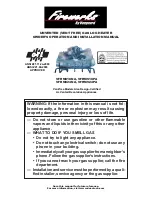
40
CONTROL SYSTEM OPERATION
CONTROL SYSTEM OPERATION
LIMITING THE RISK OF SCALDING
For a variety of reasons, water heaters can produce water that is
much hotter than its temperature setting. Take precautions to prevent
this higher temperature water from reaching the water fixtures.
Burn Hazard
To reduce the risk of unusually hot
water reaching the fixtures in the
house, install thermostatic mixing
valves at each point of use.
According to a national standard (ASSE 1070) and many local
plumbing codes, the water heater’s gas control valve should not be
used as the sole means to regulate water temperature and avoid
scalds.
A properly adjusted thermostatic mixing valve at each point of use
allows you to set the tank temperature to a higher setting without
increasing risk of scalds. A higher temperature setting allows the
tank to provide much more hot water and can help provide proper
water temperatures for appliances such as dishwashers and washing
machines.
Higher tank temperatures (140°F) also kill bacteria that cause a
condition known as “smelly water” and can reduce the levels of
bacteria that cause water-borne diseases.
CONTROL SYSTEM
The water heaters covered in this manual are equipped with an
electronic control system that regulates water temperature inside
the storage tank. Heating cycles and ignition are managed by the
control system. The ECO (energy cut out), flame sensor, pressure
switches and temperature probe are monitored by the control system.
The Combustion Blower, Spark Ignition Transformer, powered
anode rod (if applicable) and 24-volt gas valve are all powered by
the control system.
The main components of the control system are the user interface
module (UIM) and the central control board (CCB). The UIM is
located on the top front side of the water heater. The CCB is mounted
on top of the water heater inside a protective enclosure. This unit is
equipped with an Enable/Disable switch. To operate the unit, make
sure the switch is set to Enable. See
10) for location of these and all water heater components.
POWER
SUPPLY
BOARD
TRANSFORMER
CCB
BOARD
Figure 44. Control System Components
CONTROL SYSTEM NAVIGATION
All operational information and user settings are displayed and
accessed from the UIM. The UIM houses the control system’s LCD
Touch Display (liquid crystal display).
USER INPUT BUTTONS
•
The up and down buttons are used to navigate menus and adjust
user settings.
•
The operational buttons are used to enter/exit menus, select
menu items, activate adjustment modes and confirm or cancel
new user settings. The operational buttons are multifunctional,
their current function is defined by the text that appears directly
above each button on the LCD screen.
LOCK OUT FUNCTION
The water heaters covered in this manual feature a lockout
functionality that is disabled at the factory. If the lockout functionality
is required by the end user, the initial installer/contractor can access
this functionality and enable it through the UIM module.
THE DESKTOP SCREEN
During normal operation the control system will display the “Desktop”
screen on the LCD Touch Display which is the default screen. The
control system will return to the Desktop screen when there are no
active Fault or Alert conditions or when there has been no user input
for several minutes.
•
Manufacturer and water heater model information is displayed
in Title Bar at the top of the Desktop screen. Menu titles are
displayed in the Title Bar when navigating the control system
menus.
•
The temperature shown on the Desktop screen is the Operating
Set Point. The Operating Set Point is the temperature at which
the control system will maintain the water inside the storage tank.
•
Beneath the Operating Set Point is the “Status” line. The Status
line shows the current operational state of the control system in
real time. See
(page 42) for a description of the various
operational states.
•
The Desktop screen also displays animated “Status Icons” to
convey operational information. See
for
descriptions of the Status Icons.
Summary of Contents for 300 Series
Page 66: ...66 NOTES NOTES...
Page 67: ...67 NOTES NOTES...
















































